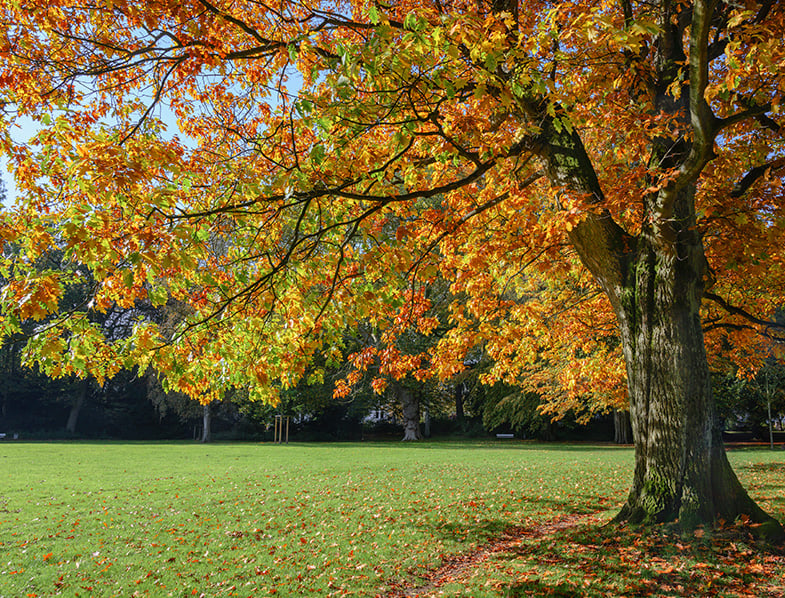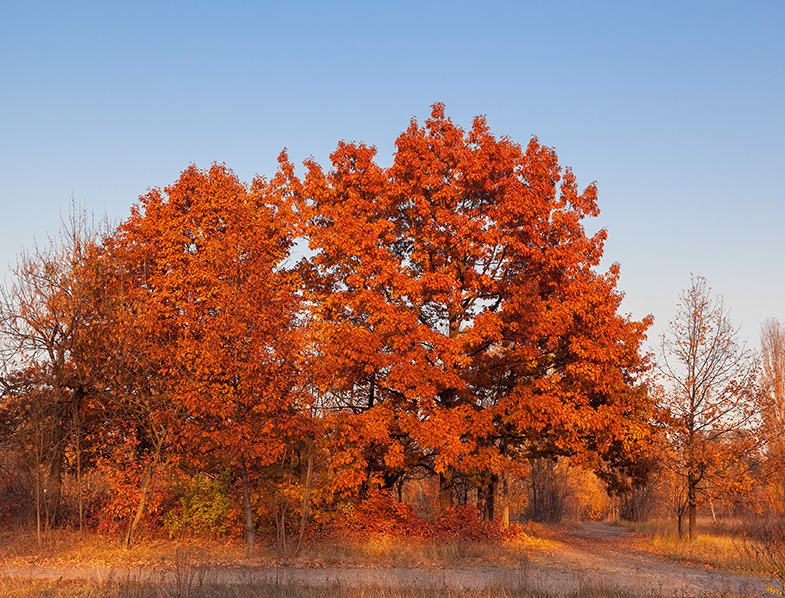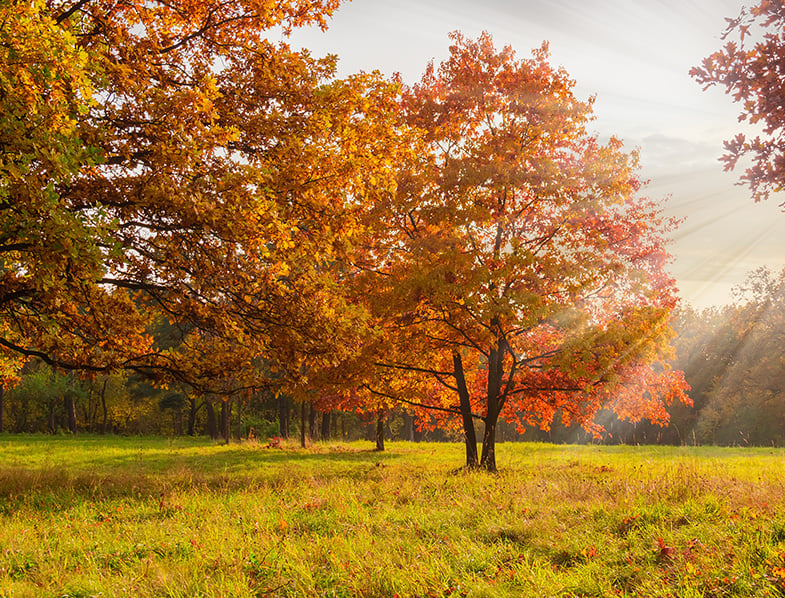Growing a red oak tree is a rewarding experience that offers a host of benefits, including shade, beauty, and providing a habitat for wildlife. Whether you’re an experienced gardener or just starting out, this guide will take you through the step-by-step process of growing a red oak tree.
Quick Facts
| Red Oak Tree Characteristics | Ideal Growing Conditions | Planting & Care |
|---|---|---|
| Known for sturdy, long-lasting wood | Grow best in full sun and well-draining soil | Requires regular watering and occasional fertilization |
| Can grow up to 100 feet tall | Good moisture retention in soil is necessary | Pruning is important to promote healthy growth |
| Dark brown bark and deep green leaves that turn red in the fall | Avoid planting near structures due to deep root system | Regular inspections are needed to detect pests and diseases |
| Produces acorns, a valuable food source for wildlife | Soil pH should fall within the ideal range of 6.0-7.0 | Trees can be planted in fall or spring, avoiding summer and freezing temperatures |
| Resistant to pests and diseases | – | Mulching around the base helps retain moisture and suppress weeds |
Understanding Red Oak Trees
Before you start the planting process, it’s important to have a basic understanding of red oak trees. These trees are known for their sturdy and long-lasting wood, making them a popular choice for furniture and flooring. They grow up to 100 feet tall and have a broad, spreading canopy that provides abundant shade.
Red oak trees have been an important part of American history, with their wood being used in the construction of homes, ships, and furniture. The wood is prized for its strength and durability, and is often used in high-end cabinetry and flooring.
Characteristics of Red Oak Trees
Red oak trees can be easily identified by their dark brown bark and deep green leaves that turn a rich red in the fall. The leaves are lobed and have pointed tips, creating an attractive and distinctive appearance. In the spring, the tree produces small, inconspicuous flowers that give way to acorns in the fall. These acorns are a valuable source of food for wildlife, including squirrels, deer, and turkeys.
Red oak trees are also known for their resistance to pests and diseases, making them a low-maintenance choice for homeowners and landscapers.
Ideal Growing Conditions for Red Oak Trees
In order for your red oak tree to thrive, it’s important to choose the right location and provide the ideal growing conditions. These trees grow best in full sun and well-draining soil that has good moisture retention. They also require regular watering and occasional fertilization to ensure healthy growth and development.
It’s important to note that red oak trees have a deep root system, so it’s best to avoid planting them near sidewalks, driveways, or other structures that could be damaged by the roots.
Benefits of Growing Red Oak Trees
Aside from their ornamental value, red oak trees provide numerous benefits to the environment. They help improve air quality by absorbing carbon dioxide and other pollutants, and provide a habitat for birds and other wildlife. Additionally, these trees are known for their longevity and can provide shade and beauty for generations to come.
Red oak trees are also a great investment for homeowners, as they can increase property values and provide energy-saving shade during the hot summer months.
Overall, red oak trees are a beautiful and valuable addition to any landscape. By understanding their characteristics and ideal growing conditions, you can ensure that your tree thrives for years to come.

Preparing the Planting Site
Planting a red oak tree is an exciting and rewarding experience that can provide shade, beauty, and environmental benefits for decades to come. To ensure your tree gets off to a healthy start, it’s important to take the time to prepare the planting site properly.
Choosing the Right Location
When selecting a location for your tree, consider its mature size and the amount of sunlight it needs to thrive. Red oak trees typically grow to be 60-80 feet tall and wide, so choose a spot that is at least 20-30 feet away from any structures or power lines. Look for an area that receives full sun for at least six hours a day and has well-draining soil. If your yard has heavy clay soil, consider planting your tree on a raised bed to improve drainage.
It’s also important to consider the surrounding landscape when choosing a location. Avoid planting your tree near other large trees or shrubs that may compete for nutrients and water. Instead, choose a spot with plenty of open space and good air circulation.
Soil Preparation
Preparing the soil is an essential step in ensuring your tree has the best possible start. Start by digging a hole that is at least twice the size of the tree’s root ball. If you’re planting multiple trees, space them at least 30 feet apart to allow for proper root growth.
Remove any rocks, roots, or debris from the soil, as these can impede root growth and cause drainage problems. If your soil is heavy clay or compacted, consider adding compost or other organic material to improve its texture and fertility.
Before planting, test your soil’s pH level to ensure it falls within the ideal range of 6.0-7.0 for red oak trees. If your soil is too acidic or alkaline, you may need to amend it with lime or sulfur to adjust the pH.
Gathering Necessary Tools and Materials
Before you start planting, gather all the necessary tools and materials to ensure a smooth and successful process. You will need a shovel, compost or other organic material, fertilizer, mulch, and water.
When selecting compost or other organic material, choose a high-quality product that is free of weed seeds and pathogens. Avoid using fresh manure, as this can burn the tree’s roots and cause nutrient imbalances.
Choose a slow-release fertilizer that is formulated for trees and shrubs, and follow the manufacturer’s instructions for application rates.
Finally, choose a high-quality mulch such as wood chips or shredded bark to help retain moisture and suppress weeds. Apply a 2-3 inch layer of mulch around the base of the tree, taking care not to pile it up against the trunk.
By taking the time to properly prepare the planting site, you can ensure your red oak tree has the best possible start and will thrive for years to come.

Planting a Red Oak Tree
Planting a red oak tree is a great way to add beauty and value to your property. Not only do they provide shade and shelter for wildlife, but they also produce acorns that are a valuable food source for many animals. Follow these steps to ensure a successful planting:
When to Plant
The best time to plant a red oak tree is in the fall, when temperatures are cooler and the soil is moist and easy to work with. This allows the tree to establish its root system before the hot summer months. However, if you missed the fall season, you can also plant in the spring. Just make sure to avoid planting in the heat of summer or during freezing temperatures.
Selecting a Healthy Sapling
When purchasing a red oak sapling, it’s important to select a healthy one. Look for one that has a straight trunk, healthy leaves, and no signs of damage or disease. The root ball should be intact and well-formed, with plenty of fibrous roots. Avoid saplings with broken or circling roots, as they may have difficulty establishing themselves in the ground.
Digging the Planting Hole
The planting hole should be at least twice the size of the root ball. This allows room for the roots to spread out and establish themselves in the soil. Loosen the soil around the edges of the hole to encourage root growth. If you have heavy clay soil, consider adding some organic matter to improve drainage and aeration.
Placing the Tree and Backfilling the Hole
Before placing the tree in the hole, remove any plastic or wire wrapping from the root ball. Place the tree in the hole, making sure the top of the root ball is level with the surrounding soil. Fill in the hole with soil and tamp down gently to remove air pockets. Water the tree thoroughly to help settle the soil around the roots.
Watering and Mulching
After planting, be sure to water your tree regularly to ensure healthy growth. A newly planted tree needs at least one inch of water per week, either from rainfall or irrigation. It’s also important to mulch around the base of the tree to help retain moisture and suppress weeds. Apply a layer of mulch that is two to three inches deep, making sure not to cover the trunk of the tree. This will also help regulate soil temperature and protect the roots from extreme heat or cold.
By following these steps, you can enjoy a beautiful and healthy red oak tree for years to come.
Caring for Your Red Oak Tree
Watering and Fertilizing
Regular watering and fertilization are essential to the health and growth of your red oak tree. Water the tree deeply once a week during dry periods, making sure the soil is moist but not waterlogged. Fertilize in the spring and fall with a balanced fertilizer that contains nitrogen, phosphorus, and potassium.
Pruning and Shaping
Pruning is important to promote healthy growth and prevent disease and damage. Remove any dead or diseased branches as soon as possible, and trim back any crossing or overcrowded branches. Shaping the tree can also help promote an attractive and symmetrical canopy.
Pest and Disease Management
Red oak trees are susceptible to a variety of pests and diseases, including oak wilt, scale insects, and galls. Regular inspections can help detect any problems early on, and prompt treatment can prevent serious damage. Consult a professional arborist if you are unsure about any potential infestations or diseases.

Conclusion
Growing a red oak tree takes patience and dedication, but the rewards are well worth it. With proper care and attention, your tree will provide beauty, shade, and environmental benefits for decades to come.
Red Oak Tree FAQS
How long does it take a red oak tree to grow?
Red oak trees grow relatively quickly for a hardwood tree, with growth rates averaging around 2 feet per year. However, they take several decades to reach their full mature height of up to 100 feet.
Are red oaks hard to grow?
Red oaks are not considered particularly difficult to grow as they are hardy and resistant to most pests and diseases. They require well-drained soil and prefer full sun. However, they do have a deep root system, so care must be taken when choosing a planting location to avoid conflicts with structures.
How do you grow a red oak tree from seed?
To grow a red oak tree from seed, first, collect acorns in the fall. Then, carry out a float test by immersing the acorns in water; discard those that float as they’re likely not viable. Stratify the good acorns by placing them in a bag of moist sand or peat moss in the refrigerator for about 1-2 months. After stratification, plant the acorns about 1-2 inches deep in well-draining soil. Keep the soil moist and protect the area from squirrels or other wildlife that might dig up the acorns.
How do you make a red oak tree grow faster?
To encourage faster growth of a red oak tree, ensure it is getting full sun and the soil is well-draining and rich in organic matter. Regular watering and applying a slow-release, balanced fertilizer in the spring and fall can also promote more rapid growth. It’s also important to avoid damage to the trunk and roots, which could slow growth.
Where do red oaks grow best?
Red oak trees are native to North America and grow best in USDA hardiness zones 3-8. They prefer full sun and well-draining soil that’s slightly acidic to neutral (pH 6.0-7.0). They can adapt to a variety of soil types, including sandy, loamy, and clay soils, as long as the drainage is good.
Do red oaks like sun or shade?
Red oaks prefer full sun. They need at least six hours of direct sunlight each day for optimal growth and development. While they can tolerate partial shade, particularly when they’re young, their growth may be slower and they may be more susceptible to pests and diseases.
